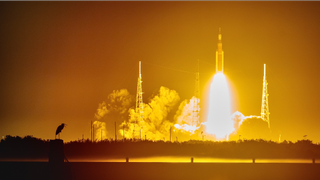
The launch of the Artemis 1 Space Launch System rocket as seen from the press site at Kennedy Space Center.
(Image credit: Josh Dinner)
NASA hasn’t yet sent an astronaut to space for the Artemis moon program, but the effort already is targeting upgrades.
A more powerful version of the Space Launch System (SLS) will launch in the coming decade for more ambitious moon missions, starting with Artemis 4. The larger version, called Block 1B, can carry both crew and big pieces of hardware towards the moon as NASA aims to build a settlement at the lunar south pole.
Features of the upgraded SLS will include a “more powerful second stage and an adapter for large cargos,” NASA officials wrote in a recent statement.
Testing on more powerful RS-25 engines for SLS is happening right now at NASA’s Stennis Space Center, upgrading the engine type first developed for the space shuttle program. NASA is performing a 12-engine hotfire certification series for the new RS-25 type, including several tests in March, to ready for Artemis 5 and beyond.
Related: NASA fires up powerful Artemis moon rocket engine in key test (video)
The greater Artemis program eventually aims for a long-term moon settlement nearby water ice resources. A coalition of nations is heading there under the NASA-led Artemis Accords, although most of the 35 signatories are not contributing hardware but instead are committing to following U.S.-led peaceful space exploration norms.
Artemis 1, an uncrewed mission, flew around the moon in 2022 and astronaut missions are coming up soon. Artemis 2 will send four astronauts around the moon no earlier than 2025, while Artemis 3 is aiming for a 2026 crewed touchdown. (Numerous technical reasons delayed the launches Artemis 2 and 3 in January, but development continues.)
These first three lunar missions use an the interim cryogenic propulsion stage to boost the Orion spacecraft, which is a single-engine stage, NASA officials explained. The missions starting with Artemis 4 will instead use a four-engine stage called the exploration upper stage (EUS). One of the benefits of EUS is a different battery that will allow it to operate for eight hours, four times what Artemis 1 and 3 are designed for. Then missions starting with Artemis 5 will receive more powerful RS-25 engines.
Artemis 4 and beyond will also have a universal stage adapter, which has more storage area and more than 10,000 cubic feet (286 cubic meters) of space to carry large components. That’s plenty of room for big items, such as modules for NASA’s future Gateway space station around the moon.
Besides more room, the more powerful EUS will increase launch opportunities to twice a day, which is more than what the current design allows, NASA said. Once the crew reaches space, astronauts and ground teams alike can communicate with the stage and control it, allowing the Orion spacecraft they’re flying to “extract components destined for Gateway from the stage adapter,” officials wrote.
NASA is also facing budgetary challenges for fiscal 2025 as it develops Artemis, but administrator Bill Nelson has vowed to fight for funding. Artemis funding in the next fiscal year is projected to be relatively flat from 2024 spending, at about $7.6 billion, if the White House request submitted this week passes Congress during an election year.
Join our Space Forums to keep talking space on the latest missions, night sky and more! And if you have a news tip, correction or comment, let us know at: [email protected].
Breaking space news, the latest updates on rocket launches, skywatching events and more!
Elizabeth Howell (she/her), Ph.D., is a staff writer in the spaceflight channel since 2022 covering diversity, education and gaming as well. She was contributing writer for Space.com for 10 years before joining full-time. Elizabeth’s reporting includes multiple exclusives with the White House and Office of the Vice-President of the United States, an exclusive conversation with aspiring space tourist (and NSYNC bassist) Lance Bass, speaking several times with the International Space Station, witnessing five human spaceflight launches on two continents, flying parabolic, working inside a spacesuit, and participating in a simulated Mars mission. Her latest book, “Why Am I Taller?”, is co-written with astronaut Dave Williams. Elizabeth holds a Ph.D. and M.Sc. in Space Studies from the University of North Dakota, a Bachelor of Journalism from Canada’s Carleton University and a Bachelor of History from Canada’s Athabasca University. Elizabeth is also a post-secondary instructor in communications and science at several institutions since 2015; her experience includes developing and teaching an astronomy course at Canada’s Algonquin College (with Indigenous content as well) to more than 1,000 students since 2020. Elizabeth first got interested in space after watching the movie Apollo 13 in 1996, and still wants to be an astronaut someday. Mastodon: https://qoto.org/@howellspace
>>> Read full article>>>
Copyright for syndicated content belongs to the linked Source : Space.com – https://www.space.com/nasa-space-launch-system-rocket-upgrade-engines-storage






























